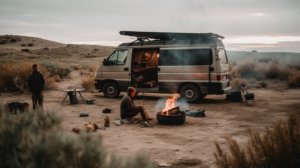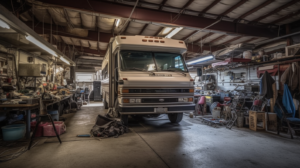
Tracy
Campfire Breakfast Burritos

Ingredients:
- 4 large eggs
- 2 sausages or 4 strips of bacon
- 1/2 cup of shredded cheese
- 2 large tortillas
Instructions:
- Start by preparing your ingredients. Crack the eggs into a bowl and whisk until smooth. Slice your sausages or bacon into bite-sized pieces.
- Cook the sausages or bacon over your campfire or on a portable stove until they are well-done. Once cooked, remove them from the heat and set them aside.
- In the same pan, pour in the whisked eggs to make scrambled eggs. Stir the eggs occasionally until they are fully cooked.
- Warm the tortillas over the campfire or stove, making sure to flip them so they heat evenly. This should take about a minute on each side, but you can warm them to your preference.
- Once your tortillas are warm, you can start to assemble your burritos. Start by laying each tortilla flat and spreading half of the scrambled eggs, cooked sausage or bacon, and shredded cheese on each one.
- Roll up your burritos by folding in the sides of the tortilla over the filling, then rolling from the bottom up. Your breakfast burritos are now ready to enjoy!
Remember, you can customize this recipe to your tastes. You might want to add some salsa, hot sauce, or even some grilled veggies for added flavor. Enjoy your campfire breakfast!
Tuna Salad Wraps for Two

Ingredients:
- 2 (5-ounce) cans of tuna
- 2 tablespoons of mayonnaise
- 1/2 cup of diced celery
- 2 large lettuce leaves
- 2 large tortilla wraps
Instructions:
- In a bowl, mix the drained tuna with the mayonnaise and diced celery until well combined.
- Lay out your tortillas and place a lettuce leaf in the middle of each one.
- Divide the tuna salad evenly between the two tortillas, placing it on top of the lettuce.
- Carefully roll up the tortillas, making sure to tuck in the ends to hold all the ingredients inside.
- Cut in half and serve immediately, or wrap them up and save them for later – they make a great on-the-go lunch option!
Chicken and Veggie Foil Packets

Ingredients:
- 2 boneless, skinless chicken breasts
- 1 red bell pepper, sliced
- 1 green bell pepper, sliced
- 1 medium onion, sliced
- 1 medium zucchini, sliced
- 2 tablespoons of olive oil
- Salt and pepper to taste
Instructions:
- Preheat your campfire or grill to medium heat.
- Take two large pieces of aluminum foil and place one chicken breast in the center of each piece.
- Divide the bell peppers, onion, and zucchini evenly between the two foil packets, arranging them around the chicken.
- Drizzle each packet with the olive oil and season with salt and pepper.
- Fold the foil over the chicken and vegetables, sealing it to create a packet.
- Place the foil packets on the campfire grill and cook for about 20-25 minutes, or until the chicken is cooked through and the vegetables are tender.
- Carefully open the packets (watch for steam), check the chicken is cooked thoroughly, and serve right from the foil for an easy clean-up. Enjoy!
Budgeting for Van Life: Tips for Saving and Managing Finances on the Road
Oh, the freedom of the open road, waking up to a new view every morning, the spontaneity and adventure that van life promises! But there’s something that needs to be addressed, something that underpins the whole van life experience – budgeting. Yep, we’re talking dollars and cents, folks! Let’s dive into understanding the costs of van life, creating a budget, saving for your adventure, and more.
Understanding the Costs of Van Life
Living the van life isn’t without its expenses. To prepare financially for van life, let’s break down the typical costs.
First, there’s the cost of purchasing or renting a van. Prices can vary dramatically based on the type of van, its age, condition, and the level of conversion if you’re looking for a camper style setup. Next up is insurance, which again can range widely based on factors like the vehicle’s value, how it’s been modified, and your travel plans.
Ongoing costs include maintenance and repairs, fuel, and if you choose, campsite fees. Van life also includes the cost of living expenses, such as food, entertainment, and perhaps a gym membership for shower facilities. And let’s not forget about setting aside an emergency fund because unexpected things do happen!
Creating a Van Life Budget
Now that we understand the costs associated with van life, it’s time to create a realistic and flexible budget. This budget should account for fixed costs (like insurance and potential campsite fees) and variable costs (like fuel, food, and fun). Don’t forget about those sneaky, occasional expenses like vehicle services or replacing worn-out gear. Keep in mind; your budget will be unique to your lifestyle and needs.
Saving for Van Life
Now you might be thinking, “Okay, this sounds a bit expensive, how can I save up for van life?” Well, there are plenty of strategies for saving money in preparation for van life. Downsizing is a big one. Before hitting the road, many people sell their belongings, which not only raises funds but also makes the transition to a minimalist lifestyle easier. Consider saving on living expenses by cutting unnecessary subscriptions, eating out less, and doing DIY projects.
Frugal Living on the Road
Living frugally on the road can make your savings stretch further. Cooking your own meals instead of dining out can make a huge difference to your wallet. Look for free camping spots using apps or websites that other van lifers recommend. Take advantage of free activities – hiking, swimming, and star-gazing don’t cost a dime! And of course, conserve resources where you can. Less water usage means fewer fill-ups, and less power usage means less fuel or time needed to recharge.
Dealing with Unexpected Costs
Unexpected costs are a part of life, even more so when your home has wheels. Having an emergency fund is crucial. This can cover unexpected repairs, healthcare costs, or travel expenses if you need to return home unexpectedly. Ensure you have adequate insurance to cover potential mishaps and save you from significant financial stress.
Tools and Resources for Managing Finances on the Road
Managing finances while traveling doesn’t have to be a chore. There are plenty of tools and resources out there to help. Budgeting apps can be a godsend, allowing you to track spending and see where your money is going. Online banking is another essential, making it easy to handle transactions and check your accounts, no matter where you are.
Conclusion
Budgeting for van life is essential for a successful and stress-free adventure. It’s not always the most fun thing to think about, but with careful planning and management, the financial side of van life can become second nature
Generating Income on the Road
While living frugally can help keep costs down, having a steady income stream while on the road can significantly ease financial stress. Here are some ways van lifers make money while traveling:
- Remote Work – With the rise of digital nomad culture, many companies are offering remote work opportunities. Skills like writing, programming, graphic design, and digital marketing are in high demand.
- Freelance Gigs – Platforms like Upwork and Fiverr connect freelancers with clients needing services, making it easy to pick up work as your travel schedule allows.
- Seasonal Work – Many van lifers plan their travels around seasonal work opportunities. Jobs at national parks, harvest work at farms, or holiday work at Amazon are just a few examples.
Money-Saving Apps and Memberships
There are plenty of apps and memberships that can save you money on the road:
- GasBuddy – This app helps you find the cheapest gas prices nearby, saving you money on one of van life’s major expenses.
- iOverlander – A crowd-sourced app that helps you find free camping spots, among other services.
- Harvest Hosts Membership – With a yearly membership, you can stay for free at hundreds of wineries, farms, and other unique locations across the USA.
- National Park Pass – If you plan to visit many national parks, this pass could save you a lot on entrance fees.
- Planet Fitness Membership – Nationwide, inexpensive, and comes with the added benefit of showers!
Remember, every penny counts when living the van life. It’s all about balancing income and expenses, and making the most out of what you have. By following these tips, you’ll be well on your way to achieving financial freedom on the road!
Transitioning to Van Life: An Insider’s Guide to Making the Move
As someone who has successfully transitioned from traditional living to the full-time van life, I can say that it’s a journey like no other. It’s a lifestyle that offers unparalleled freedom and flexibility, but also comes with its unique set of challenges. In this article, we’ll delve into the nitty-gritty of what van life entails and provide valuable insights to help you prepare for this exciting shift.
Understanding the Van Life Lifestyle
Living the van life means embracing minimalism, getting back to basics, and fostering a deeper connection with nature. It’s about enjoying the simplicity of life on the road, waking up to different vistas, and experiencing new cultures and communities. But it’s also about coping with limited space, managing resources, and sometimes dealing with unpredictable weather and road conditions. The key to enjoying the van life lifestyle is being adaptable, resourceful, and having a sense of adventure.
Preparing for the Transition

Moving from a house to a van is a significant shift, and preparation is
key. Downsizing possessions is the first step in this journey towards minimalis
m. Sell, donate, or store items you won’t need on the road. Digitize important documents, photos, and media to save space. Mentally, it’s important to set realistic expectations. Van life isn’t a permanent vacation – it’s a lifestyle, with all the ups and downs that come with it.
Choosing the Right Vehicle
Your van is going to be your home, your transport, and perhaps your workspace, so choosing the right vehicle is crucial. Consider factors such as your budget, space needs, mechanical knowledge, and where you plan to travel. Different types of vans and RVs offer different pros and cons. Research extensively, check out van life community forums, and don’t rush the decision.
The Financial Aspect of Van Life
Transitioning to van life requires financial planning. Initial costs include the vehicle purchase, conversion costs (if you’re doing a DIY build), insurance, and initial stocking up. Ongoing expenses include fuel, maintenance, campsite fees, food, and leisure activities. It’s essential to create a van life budget to manage your finances effectively. Keep track of your spending, plan for unexpected costs, and strive to live within your means.
Practicalities of Living on the Road
On the road, everyday tasks take on a new dimension. Finding places to park and sleep requires research and sometimes creativity. Managing meals means stocking up on non-perishables, planning meals, and sometimes cooking in challenging conditions. Personal hygiene could mean anything from full-fledged showers at campsites to baby wipe baths. Dealing with different weather conditions and undertaking van repairs are also part of the deal. Every day is different when you’re living the van life.
Staying Connected on the Road
Maintaining connectivity is essential, especially for those managing digital nomad work. Reliable internet is a must for work and also for leisure, navigation, and staying in touch with family and friends. Wi-Fi from cafes, libraries, and campsites is usually reliable, but it’s worth investing in a good data plan as a backup.
Building a Community
One of the most rewarding aspects of van life is the community. There’s a whole tribe of fellow van lifers out there, both online and on the road, who offer support, advice, companionship, and sometimes a helping hand. Engage with the van life community on social media, join meetups, and make an effort to connect with others. Remember, van life isn’t just about travel; it’s also about the people you meet along the way.
In conclusion, transitioning to van life is a unique journey that requires preparation, flexibility, and a sense of adventure. It’s not always a smooth ride, but the rewards – the freedom, the simplicity, and the community – make it worth the ride. Remember, it’s your journey and yours alone, so make it what you want it to be.
As you plan your shift to van life, I invite you to share your thoughts, questions, or tips about transitioning to van life in the comments below. We all learn from each other’s experiences, and your insights could be invaluable to someone else preparing for the journey.
FAQs
1. Can anyone transition to van life?
Absolutely, people of all ages and backgrounds live the van life. However, it does require planning and a willingness to live a minimalist and sometimes unpredictable lifestyle.
2. How do I earn a living on the road?
Many van lifers work remotely in a variety of fields. Others run their own businesses, freelance, or pick up work as they travel. The key is finding work that’s flexible and can be done from anywhere.
3. How do I receive mail and packages while living on the road?
You can use a mail forwarding service, ask a friend or family member to receive your mail, or have it sent to your current location if you’ll be there long enough.
4. What do I do if my van breaks down?
It’s important to have a fund for unexpected repairs. It’s also helpful to learn basic vehicle maintenance and repair skills. Building a relationship with a good mechanic before you hit the road is a great idea.
5. How do I maintain personal hygiene on the road?
Campsites and truck stops often have shower facilities. Gyms are also a good option as they usually have showers and can be found in most towns and cities. In between, wet wipes, dry shampoo, and good old-fashioned sponge baths can keep you fresh.
Remember, van life is about freedom and exploration. It’s about breaking free from the norm and embracing the open road. The journey may not always be easy, but I guarantee it will be an adventure you’ll never forget. Safe travels, and welcome to the van life community!
Maintaining Your Vehicle: An RV and Van Maintenance Checklist

If you’re a part of the RV or van life community, you know that your vehicle is more than just a method of transportation – it’s your home. So it’s not just about keeping the engine running smoothly; it’s about ensuring every aspect of your mobile dwelling is in top-notch condition. This article will take you on a journey through the importance of regular RV and van maintenance, how to understand your vehicle, and offer a detailed maintenance checklist.
Why Regular Maintenance is Crucial
Just like your stationary home, your home on wheels needs love and care. Regular maintenance isn’t just about avoiding breakdowns (although that’s certainly a big part of it); it’s about preserving and enhancing the lifespan of your vehicle, and by extension, your nomadic lifestyle. I’ve heard too many tales of full-time RV living dreams cut short due to neglected maintenance. If you want to enjoy the freedom of the open road without worrying about the next potential issue, routine maintenance checks are absolutely crucial.
Understanding Your Vehicle
Whether you’re driving a brand new RV or a retrofitted van, understanding your vehicle’s systems – from the engine to the plumbing and electrical – is an essential part of the van life and RV living. Every make and model is different, and getting to know your vehicle’s unique quirks and features is a journey in itself. Grab that owner’s manual, do your research, and become best friends with your home-on-wheels.
General Maintenance Tips
When it comes to maintenance, consistency is key. Developing a routine and schedule for your maintenance tasks will help ensure nothing slips through the cracks. This includes both professional inspections and DIY checks. Even if you’re not mechanically inclined, there are plenty of simple maintenance tasks you can perform yourself.
Remember, while living the van life or RV life, you might be miles away from the nearest mechanic when an issue crops up. Learning how to handle small fixes can save you a lot of time, money, and stress.
Maintenance Checklist
Here’s the bread and butter of your RV and van maintenance: the checklist. Depending on your specific vehicle and how much you’re using it, some of these tasks might need to be performed more or less frequently. But as a starting point:
- Engine and transmission – Regular oil changes, checking transmission fluid, inspecting belts and hoses.
- Tires and brakes – Regular rotation and balancing, checking tread depth and brake pads.
- Interior and exterior – Sealing any leaks, checking for rust or damage, cleaning and treating surfaces.
- Plumbing system – Cleaning and treating the waste water system, checking for leaks, winterizing if necessary.
- Electrical system – Inspecting wiring, checking battery health, testing outlets and appliances.
- Heating and cooling systems – Cleaning and maintaining the A/C unit and heating system, replacing filters as needed.
Tool Essentials for RV/Van Maintenance
Just like a handyman needs his toolbox, you’ll need a set of essential tools for your basic RV and van maintenance. This includes a quality set of screwdrivers, wrenches, pliers, a tire pressure gauge, a multimeter for electrical tasks, and a reliable flashlight. Don’t forget important spare parts like fuses, bulbs, belts, and hoses specific to your vehicle.
And, since space is always a premium in RV and van life, make sure to store these tools efficiently. A compact, organized tool kit is worth its weight in gold on the road.
Finding a Reliable Mechanic
While DIY maintenance is a big part of RV living and the van life, there are times when you’ll need a professional’s touch. Start by lookingfor a trustworthy RV or van mechanic before you hit the road. Check reviews, ask for recommendations from the community, and take the time to build a relationship with them. Having a pro you can call when things go south can be a huge relief, and their expert advice can be invaluable.
Conclusion
Maintenance may not be the most glamorous part of RV living or the van life, but it’s certainly one of the most important. Keeping your vehicle – your home – in top shape ensures the freedom and joy of the open road continue unhindered. I hope this article has underscored the significance of regular checks and given you a practical guide to follow.
Call to Action
Do you have any of your own RV or van maintenance tips? Maybe a funny story about a DIY fix on the road? We’d love to hear it! Feel free to comment below and share your experiences. And if you need any tools or services mentioned in this article, check out our recommended resources.
FAQs
Q: How often should I perform these maintenance checks? A: The frequency of maintenance checks can depend on many factors including your vehicle’s age, the distance traveled, and the conditions in which you’re traveling. As a general rule, an overall check before and after long trips is a good practice. Always refer to your vehicle’s owner’s manual for manufacturer-specific advice.
Q: I’m not mechanically minded. Can I still do some of my own RV or van maintenance? A: Absolutely! While some tasks might require a professional, many routine checks and maintenance tasks can be done by anyone. Start by getting to know your vehicle, understand its systems and take baby steps towards DIY maintenance. There are also numerous resources and tutorials available online to help you learn.
Q: What should I do if I breakdown in a remote area? A: First things first – it’s essential to have a plan before you hit the road. This includes having roadside assistance coverage, knowing the location of nearby mechanics or service centers along your route, and carrying essential tools and spare parts for emergency repairs. Always let someone know your route and check-in regularly, especially when traveling in remote areas.









